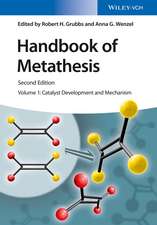Qualitative Organic Microanalysis: Cognition and Recognition of Carbon Compounds: Monographien aus dem Gebiete der qualitativen Mikroanalyse, cartea 2
Autor Frank Schneideren Limba Engleză Paperback – 14 iun 2012
Preț: 407.56 lei
Nou
Puncte Express: 611
Preț estimativ în valută:
77.98€ • 81.43$ • 64.40£
77.98€ • 81.43$ • 64.40£
Carte tipărită la comandă
Livrare economică 15-29 aprilie
Preluare comenzi: 021 569.72.76
Specificații
ISBN-13: 9783709158296
ISBN-10: 370915829X
Pagini: 556
Ilustrații: XII, 536 p. 125 illus.
Greutate: 0.88 kg
Ediția:Softcover reprint of the original 1st ed. 1964
Editura: SPRINGER VIENNA
Colecția Springer
Seria Monographien aus dem Gebiete der qualitativen Mikroanalyse
Locul publicării:Vienna, Austria
ISBN-10: 370915829X
Pagini: 556
Ilustrații: XII, 536 p. 125 illus.
Greutate: 0.88 kg
Ediția:Softcover reprint of the original 1st ed. 1964
Editura: SPRINGER VIENNA
Colecția Springer
Seria Monographien aus dem Gebiete der qualitativen Mikroanalyse
Locul publicării:Vienna, Austria
Public țintă
ResearchCuprins
I Fundamental Techniques and Preparation of Sample.- I. Fundamental Apparatus and Operations.- Capillaries.- Microscope Slides.- Microcones.- Spot Plates.- Reflex Tubes.- Microbeakers.- Determination of Weight.- The Microscope.- Reagents.- II. Preparation of the Sample.- Tests for Purity.- Separation of Minor Components and Impurities.- Mechanical Separation.- Distillation.- Fractional Distillation.- Recrystallization.- Zone Melting.- Extraction.- Sublimation.- Drying and Removal of Solvent.- Separation of Mixtures.- Heterogeneous Mixtures.- Homogeneous Mixtures.- II Preliminary Examination.- III. Elementary Analysis.- Carbon.- Water.- Oxygen.- Other Elements.- Decomposition of the Substance.- Nitrogen.- Halogens.- Other Tests for Halogens.- Sulfur.- Phosphorus.- Arsenic.- Silicon.- Metals.- Quantitative Elementary Analysis.- IV. Determination of Physical Constants.- Melting Point.- Boiling Point.- Density.- Refractive Index.- Solids.- Liquids.- Crystallographic Properties.- Crystal Optical Properties.- Molecular Weight Determination.- Specific Rotation.- V. Solubility.- Solvents.- Determination of Solubility.- Application of Solubility Data.- III Systematic Analysis.- VI. Compounds of Order I.- Aldehydes.- Generic Test.- Classification Tests for Aldehydes.- Derivatives of Aldehydes.- Degradative Procedures.- Chemical Separation of Aldehydes.- Quantitative Determination of Aldehydes.- Carbohydrates.- Generic Test.- Supplementary Tests.- Sectional Tests.- Classification Tests for Carbohydrates.- Crystallization Test.- Degradative Procedures.- Chemical Separation of Carbohydrates.- Quantitative Analysis of Carbohydrates.- Acids.- Generic Test.- Divisional Test.- Sectional Tests.- Classification Tests.- Derivatives of Acids.- Degradative Procedures for Acids.- Chemical Separation of Acids.- Quantitative Analysis of Acids.- Phenols.- Generic Tests.- Classification Tests for Phenols.- Derivatives of Phenols.- Degradative Procedures.- Chemical Separation of Phenols.- Quantitative Determination of Phenols.- Esters.- Generic Test.- Derivatives of Esters.- Degradative Procedures.- Chemical Separation of Esters.- Quantitative Determination of Esters.- Acid Anhydrides and Lactones.- Titration of Anhydrides and Lactones.- 2,4-Dichloroanilides of Anhydrides.- Degradative Procedures.- Chemical Separation.- Quantitative Determination.- Ketones.- Generic Test.- Derivatives of Ketones.- Degradative Procedures.- Chemical Separation of Ketones.- Quantitative Determination of Ketones.- Alcohols.- Generic Test.- Classification Test for Alcohols.- Derivatives of Alcohols.- Degradative Procedures for Alcohols.- Chemical Separation of Alcohols.- Quantitative Determination of Alcohols.- Hydrocarbons and Ethers.- Sectional Tests.- Classification Tests.- Derivatives of Hydrocarbons and Ethers.- Degradative Procedures for Hydrocarbons and Ethers.- Chemical Separation of Hydrocarbons and Ethers.- Quantitative Determination of Hydrocarbons.- Ethers.- VII. Compounds of Order II.- Genus 1. Acidic Species.- Classification Reactions.- Derivatives of Amino Acids.- Degradative Procedures for Acidic Nitrogen Compounds.- Chemical Separation of Acidic Nitrogen Compounds.- Genus 2. Basic Species.- Classification Reactions.- Derivatives of Amines.- Degradative Procedures.- Chemical Separation.- Quantitative Determination.- Genus 3. Neutral Species.- Classification Tests.- Derivatives of Neutral Species.- Degradative Procedures for Neutral Species.- Quantitative Determination of Neutral Species.- VIII. Compounds of the Higher Orders.- Halogen Compounds.- Classification Test.-Derivatives of Halogen Compounds.- Degradative Procedures for Halogen Compounds.- Chemical Separation of Halogen Compounds.- Quantitative Determination of Halogen Compounds.- Sulfur Compounds.- Classification Test.- Derivatives of Sulfur Compounds.- Degradative Procedures for Sulfur Compounds.- Chemical Separation of Sulfur Compounds.- Quantitative Determination of Sulfur Compounds.- Literature Cited.- Tables of Physical Constants of Compounds and Derivatives Classified by Orders, Genera, Divisions, and Sections.- Arrangement of Tables and Data.- Notes on the Use of the Tables.- Table 1–1-A. Aldehydes, Solid.- Table 1–1-B. Aldehydes, Liquid.- Table 1–2-A. Carbohydrates.- Table 1–3-A. Acids, Solid.- Table 1–3-B. Acids, Liquid.- Table 1–4-A. Phenols, Solid.- Table 1–4-B. Phenols, Liquid.- Table 1–5-A. Esters, Solid.- Table 1–5-B. Esters, Liquid.- Table 1–6-A. Anhydrides, Solid.- Table 1–6-B. Anhydrides, Liquid.- Table 1–7-A. Ketones, Solid.- Table 1–7-B. Ketones, Liquid.- Table 1–8-A. Alcohols, Solid.- Table 1–8-B. Alcohols, Liquid.- Table 1–9-A-1. Hydrocarbons, Solid, Non-Aromatic.- Table 1–9-A-2. Hydrocarbons, Solid, Aromatic.- Table 1–9-A-3. Ethers, Solid.- Table 1–9-B-l. Hydrocarbons, Liquid, Aromatic.- Table 1–9-B-2. Ethers, Liquid.- Table 1–9-B-3. Hydrocarbons, Liquid. Alkynes, Terpenes, etc.- Table 1–9-B-4. Hydrocarbons, Liquid. Alkenes.- Table 1–9-B-5. Hydrocarbons, Liquid. Alkanes.- Table 2–1–1. Acid Nitrogen Compounds. Amino Acids.- Table 2–1–2. Acid Nitrogen Compounds. Other Acids and Anhydrides.- Table 2–1–3. Acid Nitrogen Compounds. Nitrophenols.- Table 2–1–4. Acid Nitrogen Compounds, Azophenols.- Table 2–1–5. Acid Nitrogen Compounds. Other Nitrogen Phenols.- Table 2–2–1. Basic NitrogenCompounds. Primary and Secondary.- Table 2–2–2. Basic Nitrogen Compounds. Primary and Secondary Amines. Liquid.- Table 2–2–3. Basic Nitrogen Compounds. Tertiary Amines, Solid.- Table 2–2–4. Basic Nitrogen Compounds. Tertiary Amines, Liquid.- Table 2–2–5. Basic Nitrogen Compounds. Aminophenols.- Table 2–3–1. Neutral Nitrogen Compounds. Aldehydes.- Table 2–3–2. Neutral Nitrogen Compounds. Carbohydrates.- Table 2–3–3. Neutral Nitrogen Compounds. Nitriles, Solid.- Table 2–3–4. Neutral Nitrogen Compounds. Nitriles, Liquid.- Table 2–3–5. Neutral Nitrogen Compounds. Esters.- Table 2–3–6. Neutral Nitrogen Compounds. Ketones.- Table 2–3–7. Neutral Nitrogen Compounds. Quinones.- Table 2–3–8. Neutral Nitrogen Compounds. Alcohols.- Table 2–3–9. Neutral Nitrogen Compounds. Ethers.- Table 2–3–10. Neutral Nitrogen Compounds. Nitrohydrocarbons, Solid.- Table 2–3–11. Neutral Nitrogen Compounds. Nitrohydrocarbons, Liquid.- Table 2–3–12. Neutral Nitrogen Compounds. Miscellaneous.- Table 3–1-A. Chlorine Compounds. Aldehydes, Solid.- Table 3–1-B. Chlorine Compounds. Aldehydes, Liquid.- Table 3–2. Chlorine Compounds. Acids and Anhydrides.- Table 3–3. Chlorine Compounds. Acyl Chlorides.- Table 3–4. Chlorine Compounds. Phenols.- Table 3–5. Chlorine Compounds. Esters.- Table 3–6. Chlorine Compounds. Ketones.- Table 3–7. Chlorine Compounds. Alcohols.- Table 3–8. Chlorine Compounds. Ethers.- Table 3–9-A. Chlorine Compounds. Hydrocarbons, Solid.- Table 3–9-B. Chlorine Compounds. Hydrocarbons, Liquid.- Table 4–1. Bromine Compounds. Aldehydes.- Table 4–2. Bromine Compounds. Acids and Anhydrides.- Table 4–3. Bromine Compounds. Acyl Bromides.- Table 4–4. Bromine Compounds. Phenols.- Table 4–5. BromineCompounds. Esters.- Table 4–6. Bromine Compounds. Ketones.- Table 4–7. Bromine Compounds. Alcohols.- Table 4–8. Bromine Compounds. Ethers.- Table 4–9. Bromine Compounds. Hydrocarbons.- Table 5–1. Iodine Compounds. Aldehydes and Ketones.- Table 5–2. Iodine Compounds. Acids and Anhydrides.- Table 5–3. Iodine Compounds. Acyl Iodides.- Table 5–4. Iodine Compounds. Phenols.- Table 5–5. Iodine Compounds. Ethers.- Table 5–6. Iodine Compounds. Hydrocarbons.- Table 6–1. Fluorine Compounds. Aldehydes and Ketones.- Table 6–2. Fluorine Compounds. Acids and Anhydrides.- Table 6–3. Fluorine Compounds. Acyl Fluorides.- Table 6–4. Fluorine Compounds. Esters.- Table 6–5. Fluorine Compounds. Alcohols.- Table 6–6. Fluorine Compounds. Ethers.- Table 6–7. Fluorine Compounds. Hydrocarbons.- Table 7–1. Sulfur Compounds. Aldehydes and Ketones.- Table 7–2. Sulfur Compounds. Carboxylic Acids.- Table 7–3. Sulfur Compounds. Thiols and Thiophenols.- Table 7–4. Sulfur Compounds. Sulfides and Disulfides.- Table 7–5. Sulfur Compounds. Cyclic Thioethers.- Table 7–6. Sulfur Compounds. Esters.- Table 8–1. Silicon Compounds. Silicates.- Table 8–2. Silicon Compounds. Alkoxy Silanes.- Table 8–3. Silicon Compounds. Alkoxy Siloxanes.- Table 8–4. Silicon Compounds. Silanols.- Table 8–5. Silicon Compounds. Silanes.- Table 9–1. Higher Orders. Acids.- Table 9–2. Higher Orders. Phenols.- Table 9–3. Higher Orders. Amino Compounds.- Table 9–4. Higher Orders. Acyl Halides.- Table 9–5. Higher Orders. Halides and Nitro Compounds.- Table 9–6. Higher Orders. Sulfonamides.- Table 9–7. Higher Orders. Nitriles.- Table 9–8. Higher Orders. Chlorosilanes.- Table 9–9. Higher Orders. Miscellaneous.













